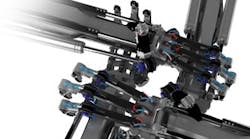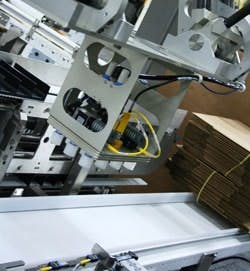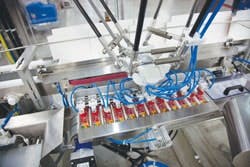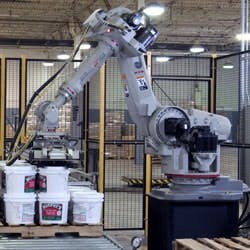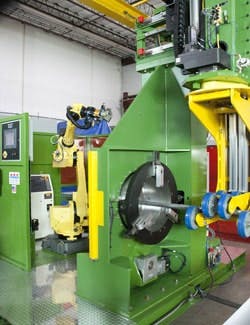Dan Hebert is senior technical editor for Control, Control Design and Industrial Networking. Email him at [email protected] or check out his Google+ profile.
According to the Robotic Industries Assn. (RIA), robot sales are booming. A total of 16,363 robots valued at $1.1 billion were ordered in the first nine months of 2012 by companies in North America, RIA says, an increase of 20% in units and 29% in dollars over the same period in 2011. One reason might be because even high-performance robots are dropping to attractive price levels. ST Robotics recently announced the Tandem R125, with two five-axis vertically articulated robot arms, for $20,000.SEE ALSO: Robots Fuse Performance and Profitability
For many machine builders, modern robots are a tool, like a press or an injection molder. And, because robots have progressed to the point where use and integration is much simpler, vast opportunities open up for use in factory automation.
Of particular interest are production lines where robots are tightly integrated with machines to create a highly automated system that eliminates intermediate material handling tasks.
One major trend in robots sees machine builders programming the robots themselves, using PLCs or industrial computers instead of relying on the proprietary controls supplied by the robot vendors. One machine builder does both, but is very selective about which systems are controlled by PLCs.
Oystar North America in Covington, Ky., uses delta and articulated-arm robots for pick-and-place applications on the cartoners it builds. The robots often are equipped with vision to more quickly and easily locate randomly placed products. The robot control systems connect over EtherNet/IP to the machine’s Rockwell PLC and HMIs. Robots are supplied by Fanuc, Adept and Kuka, depending on the application.
Oystar uses both proprietary controls and PLCs to control the robots. "We use the robot manufacturer's control system to set up and control the robot, but then communicate recipes, handshakes and parameters between it and the PLC that controls the cartoner," explains Scott Bivens, director of electrical engineering at Oystar. "We also have some lower-tech robotic applications controlled solely by programming and coordinated motion instructions in the cartoner PLC and integrated servo platform."
Bivens says he would rather use the robot vendor's controller for high-complexity applications than try to do complex operations in a PLC. "It would take a lot of time and resources for a machine manufacturer to develop the technology that robot manufacturers already have developed and provide in their control systems," he notes. "This is especially true when vision is part of the control."
Robots Join the Team
Intelligrated in Cincinnati builds material handling solutions. "Robots become faster and more cost-effective every day," says Earl Wohlrab, manager of robotic integration. "This allows us to move robotics into places that were previously unthinkable."
Intelligrated uses robots for simple, end-of-line palletizing cells, complex multi-line palletizing systems, case packing, depalletizing systems and other material handling applications.
System integrator Concept Systems in Albany, Ore., uses robots and vision systems, which have simplified machine design, according to Michael Gurney, co-CEO at Concept Systems. Robots eliminate the need for mechanical guides and fixtures, thus minimizing product changeover times, simplifying the parts-feed process, and eliminating many mechanical components, he explains.
Robots now are just part of a manufacturing line, says Pete Squires, vice president, Schneider Packaging Equipment in Brewerton, N.Y. "To us, a robot is a very reliable and capable tool we integrate into a system," he reports. "Much like a peripheral device such as a printer, you set it up and it works. Treating the robot and its controller as just another peripheral device makes it easy for the user to operate and maintain."
For nearly all of Schneider's robotic solutions, a PLC and HMI is the system master, not the robot, Squires says. "We design our equipment to keep the robot as transparent to the customer as possible, with all normal functions of control and monitoring done through a Rockwell Automation platform," he explains. "That way, our customers do not have to become robot experts — we provide that expertise for them."
If you can't find what you need, robot vendors will build it for you, says Tom Hasse, industrial automation and process control consultant at Frost & Sullivan in Mountain View, Calif. "For special applications that require complex movements and/or interactions with other robots, robot manufacturers will provide a work-cell solution that is more cost-effective for the machine builder."
Robots at Work
There are many conceptual reasons to use robots in production lines. Delkor Systems in St. Paul, Minn., uses robots in its packaging equipment (Figure 1). "We use robots primarily to load product into trays, cartons or cases, as they provide reliable, quality operation and speed, plus allow flexibility to accommodate customer-specific requirements," explains Adam Koller, director of engineering at Delkor. "The robots pick random product off a conveyor using cameras, or pick pre-collated product from a collation belt."
The robots are part of a complete line. "Typically, the lines are built in a modular fashion and consist of a carton-forming machine running anywhere from 30 to 200 cartons per minute, a product collation section, a robotic loading cell, and a carton-closing machine," Koller says. "Conveyors connect the modules to one another."
Machine builder Aagard, based in Alexandria, Minn., uses robots in its carton packaging machinery. "Our latest robotic solution is a Codian D4-100 Delta robot driven by low-inertia servo motors and servo drives," notes Steve Mulder, president.
Aagard uses the Integrated Architecture platform from Rockwell Automation on its packaging machinery, and can drive the robots from the ControlLogix platform that controls the entire system, or use a more modular and scaleable approach where a separate CompactLogix controls the robot. Either way, Aagard's customers only have to deal with one automation system.
"We always prefer to supply a turnkey system," Delkor's Koller reports. "The benefits for our customers include full line support for the sales and application engineering, service, aftermarket support, system-wide safety risk assessment, and a performance guarantee covering overall operational efficiency."
With many end users employing fewer engineering personnel, the turnkey approach should gain favor because it requires much less in the way of manpower from the end user. Although overall upfront costs of a turnkey approach are higher, the benefits are often substantial enough to justify it — chief among them a transfer of risk from the end user to the machine builder.
SEE ALSO: Brave New Robot World
Whose Solution to Use?
As complete integration approaches, it raises the question of what control system to use. Most robot vendors use their own proprietary control systems, but an integrated automation line might require a general-purpose control system. Each approach has its advantages.
There's no consensus among machine builders and system integrators about whether to use the proprietary control system that comes with the robot — or to do the robot programming themselves with PLCs, programmable automation controllers (PACs) or industrial computers. Some are adamant about proprietary controllers, some use both, and some look forward to general-purpose control.
|
"We prefer to keep the robot control with the manufacturer's controller," says John Martin, senior project manager at Arc Specialties in Houston. "Many man-years have been invested in the refinement of these algorithms, and our value as machine builders is not to recreate this, but to instead apply this technology to real-world applications."
There are both technical and ease-of-use reasons for robot proprietary systems, adds Terry Zarnowski, director of sales and marketing at Schneider Packaging Equipment. "Much of this has to do with the tight, high-speed, closed-loop control needed to ensure the speed and accuracy of the arm and the tooling," he explains. "The robot controller also tightly integrates machine vision. There is no need to reinvent or rewrite software that is provided by the robot manufacturer."
But some machine builders are doing just that, depending on the specific situation. Arc Specialties and Concept Systems have both developed their own robot controls using a general-purpose motion control system, and some machine builders control with PLCs.
Intelligrated uses PLCs to control some of the robots provided with its integrated material handling systems. "Today, the vast majority of robotic solutions involve the use of robotic proprietary controls supplied by the manufacturer. This makes sense in a lot of ways, but PLCs are gaining traction in the material-handling business," Wohlrab says. "I envision a future where a single PLC will control small packaging lines that include several robots."
Intelligrated's Alvey robotic palletizer (Figure 2) is controlled by a PLC provided and programmed by Intelligrated. According to the company, the new control system improves line integration, response time and overall productivity while reducing operator and maintenance training.
Of course, control automation suppliers would like to see everybody change from proprietary systems. Phoenix Contact and others already supply some robot vendors with their controllers. "Today, robots typically are handled by a special-purpose controller, but sequenced and monitored by a general-purpose automation system," explains Loren Brown, solutions engineer at Phoenix Contact. "However, the runtime engine in our PLCs also is licensed by robot manufacturers for use in their special-purpose controllers. Our PLCs can control the machine and robot cells using onboard I/O and remote I/O stations."
Rockwell Automation is making similar gains. "Denso introduced new Add-On Instructions (AOIs) for its RC7 robot controller, which allow Denso robots to be controlled and programmed directly from a CompactLogix PLC or ControlLogix PAC via EtherNet/IP," reports Amy Peters, manager of business strategy and portfolio planning for Rockwell Automation. "Rockwell's control platforms have become standard for many of the robot vendors' customers, including machine builders and end users globally."
Custom Welding Systems"We integrated a Fanuc robotic arm with a Beckhoff PLC to fabricate a high-pressure connector using a gas tungsten arc-welding process," says John Martin, senior project manager. "The PLC controlled the welding process, the robot manipulated the welding torch, and the user interface served as the single point of control."
Martin says the company likes to use six-axis robots whenever it can because they provide advantages to customers. "If we integrate a standard six-axis articulated arm in place of a custom four-axis system, we offer our customers a more flexible machine at a similar price point," he says. "However, to implement a robotic solution that is as user-friendly as a custom four-axis system, an intuitive user interface and oftentimes an external PLC is required."
Arc offers a machine that welds two cylindrical parts together with a hot wire TIG process. "It has a welding torch mounted to X/Y/Z cross slides and a part rotation axis," Martin says. "When a customer asked what it would cost to add a torch angle axis to the system, we offered them a robotic-based solution at no increase in cost." The robot overcame torch positioning limitations and gave the customer a system that could be used for other product lines not initially intended for the system.
"The key to this system's success was integration of the process controls with the flexibility of the robot," Martin says. “The robot was a piece of hardware embedded in the system. But without an intuitive interface to simplify operation or a PLC controlling the process, a robot alone would not have been successful."
Sometimes Arc Specialties uses a general-purpose controller to automate a robot. "We used a Delta Tau motion control system to control a five-axis kinematic robot," Martin explains. "This system has an X/Y/Z manipulator around 18 ft tall, a 10 ft long torch angle axis, and a two-axis positioner for tilt and rotation of a part. We had to write the code to control this system because no off-the-shelf robot was available with the required range of motion."
There is a clear trend toward more robotic systems controlled and monitored by general-purpose automation systems, according to Matt Lecheler, motion specialist at Beckhoff Automation. "This is made possible by three important factors: multicore processor technology, common PC-based programming environments, and industrial Ethernet," he says. "The rise of multicore processors in industrial PCs raised the raw performance of PC-based controls to accommodate the bundling of many complex functions onto one powerful device."
Marvin Tisdale, manager of automotive and mobile solutions for Lenze Americas, sums up the present approach: "Proprietary systems for six-axis robot control are the rule, not the exception. Delta or SCARA-type robots requiring only three or four axes are more likely candidates for general-purpose controls."
Tighter Links Bring Benefits
The near future holds promise of increased robot use, and tighter integration with general-purpose automation systems.
"From the machine builder's perspective, this simply makes the most sense," Lecheler says. "Driven to increase performance and efficiency, machine builders and robot designers increasingly control robotic equipment with the same industrial PC hardware that controls other machine functions."
Rockwell's Peters also sees end user benefits from using general-purpose controllers to automate robots. "Using a standard control system to integrate robots helps mitigate line-integration issues, as end users have one point of contact to call for troubleshooting and support," she notes. "For many end users who are downsizing staff and seeing many of their experienced workers retire, outside expertise is important."
Peters sees three integration methods coming to the robot industry:
1. Networking using standard technologies such as EtherNet/IP to connect all equipment in a manufacturing line.
2. Embedded robot control, with the controller being a standard PLC or PAC.
3. Integrated control solutions, with all configuration, programming, kinematics, troubleshooting and operations performed within a single control platform.
